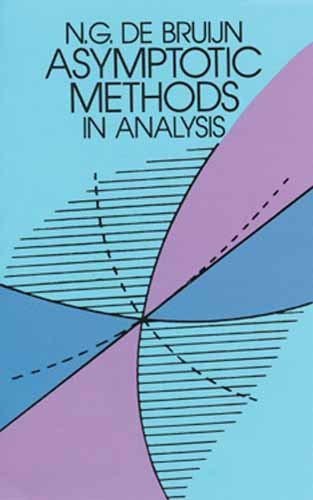

Most ebook files are in PDF format, so you can easily read them using various software such as Foxit Reader or directly on the Google Chrome browser.
Some ebook files are released by publishers in other formats such as .awz, .mobi, .epub, .fb2, etc. You may need to install specific software to read these formats on mobile/PC, such as Calibre.
Please read the tutorial at this link. https://ebooknice.com/page/post?id=faq
We offer FREE conversion to the popular formats you request; however, this may take some time. Therefore, right after payment, please email us, and we will try to provide the service as quickly as possible.
For some exceptional file formats or broken links (if any), please refrain from opening any disputes. Instead, email us first, and we will try to assist within a maximum of 6 hours.
EbookNice Team

Status:
Available0.0
0 reviews
ISBN-10 : 0486642216
ISBN-13 : 9780486642215
Author: N. G. de Bruijn
"A reader looking for interesting problems tackled often by highly original methods, for precise results fully proved, and for procedures fully motivated, will be delighted." — Mathematical Reviews.
Asymptotics is not new. Its importance in many areas of pure and applied mathematics has been recognized since the days of Laplace. Asymptotic estimates of series, integrals, and other expressions are commonly needed in physics, engineering, and other fields. Unfortunately, for many years there was a dearth of literature dealing with this difficult but important topic. Then, in 1958, Professor N. G. de Bruijn published this pioneering study. Widely considered the first text on the subject — and the first comprehensive coverage of this broad field — the book embodied an original and highly effective approach to teaching asymptotics. Rather than trying to formulate a general theory (which, in the author's words, "leads to stating more and more about less and less") de Bruijn teaches asymptotic methods through a rigorous process of explaining worked examples in detail.
Ch. 1. Introduction
1.1. What is asymptotics?
1.2. The O-symbo
1.3. The o-symbo
1.4. Asymptotic equivalence
1.5. Asymptotic series
1.6. Elementary operations on asymptotic series
1.7. Asymptotics and Numerical Analysis
1.8. Exercises
Ch. 2. Implicit Functions
2.1. Introduction
2.2. The Lagrange inversion formula
2.3. Applications
2.4. A more difficult case
2.5. Iteration methods
2.6. Roots of equations
2.7. Asymptotic iteration
2.8. Exercises
Ch. 3. Summation
3.1. Introduction
3.2. Case a
3.3. Case b
3.4. Case c
3.5. Case d
3.6. The Euler-Maclaurin sum formula
3.7. Example
3.8. A remark
3.9. Another example
3.10. The Stirling formula for the Γ-function in the complex plane
3.11. Alternating sums
3.12. Application of the Poisson sum formula
3.13. Summation by parts
3.14. Exercises
Ch. 4. The Laplace Method for Integrals
4.1. Introduction
4.2. A general case
4.3. Maximum at the boundary
4.4. Asymptotic expansions
4.5. Asymptotic behaviour of the Γ-function
4.6. Multiple integrals
4.7. An application
4.8. Exercises
Ch. 5. The Saddle Point Method
5.1. The method
5.2. Geometrical interpretation
5.3. Peakless landscapes
5.4. Steepest descent
5.5. Steepest descent at end-point
5.6. The second stage
5.7. A general simple case
5.8. Path of constant altitude
5.9. Closed path
5.10. Range of a saddle point
5.11. Examples
5.12. Small perturbations
5.13. Exercises
Ch. 6. Applications of the Saddle Point Method
6.1. The number of class-partitions of a finite set
6.2. Asymptotic behaviour of dn
6.3. Alternative method
6.4. The sum S(s, n)
6.5. Asymptotic behaviour of P
6.6. Asymptotic behaviour of Q
6.7. Conclusions about S(s, n)
6.8. A modified Gamma Function
6.9. The entire function G0(s)
6.10. Conclusions about G(s)
6.11. Exercises
Ch. 7. Indirect Asymptotics
7.1. Direct and indirect asymptotics
7.2. Tauberian theorems
7.3. Differentiation of an asymptotic formula
7.4. A similar problem
7.5. Karamata’s method
7.6. Exercises
Ch. 8. Iterated Functions
8.1. Introduction
8.2. Iterates of a function
8.3. Rapid convergence
8.4. Slow convergence
8.5. Preparation
8.6. Iteration of the sine function
8.7. An alternative method
8.8. Final discussion about the iterated sine
8.9. An inequality concerning infinite series
8.10. The iteration problem
8.11. Exercises
Ch. 9. Differential Equations
9.1. Introduction
9.2. A Riccati equation
9.3. An unstable case
9.4. Application to a linear second-order equation
9.5. Oscillatory cases
9.6. More general oscillatory cases
9.7. Exercises
asymptotic methods in analysis pdf
asymptotic methods in analysis bruijn pdf
asymptotic methods in analysis by n.g. de bruijn
how to do asymptotic analysis
what is asymptotic analysis
Tags: Asymptotic methods, analysis MCap, Bruijn